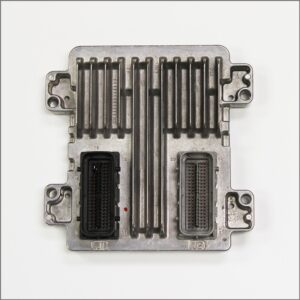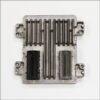Restore Peak Performance to Your GM Truck or SUV
Is your truck plagued by a persistent Check Engine Light, rough idling, or frustrating no-start conditions? You’re not alone. The Engine Control Module (ECM) is the brain of your vehicle’s powertrain, and when it starts to fail, it can cause a cascade of problems that are often difficult to diagnose. This isn’t just an inconvenience; it can affect fuel economy, transmission performance, and overall reliability. This replacement ECM, part number 12633238, is the definitive solution to get your vehicle running like new again.
We take the guesswork and high dealership costs out of the equation. Unlike a generic module from a parts store, this ECM arrives at your door programmed with the latest official GM software, specifically matched to your vehicle’s VIN. This ensures perfect communication between all onboard systems and restores the precise engine management parameters your truck was designed with. For the professional mechanic, this means a faster, more reliable repair and a satisfied customer. For the DIYer, it means you can confidently tackle this job without needing expensive dealer-specific scan tools for programming.
Case Study: A Tricky Diagnosis
I remember a 2010 Sierra 3500 work truck that came into my bay with an intermittent no-start and a P0601 (Internal Control Module Memory Check Sum Error) code. The owner had already replaced the battery and checked the main power and ground wires to the ECM, but the problem persisted. These internal processor faults are notorious. After confirming the wiring harness was solid, we installed one of our VIN-programmed ECMs. The key is that the module wasn’t just replaced; it was loaded with the correct, updated software before it ever left our facility. The truck fired up instantly, the code was gone for good, and it passed its emissions test the next day. It saved the owner from a costly dealership visit and got his work truck back on the road earning money.
Common Signs of a Failing ECM
If you’re experiencing any of the following issues, a faulty engine computer could be the culprit. A failing ECM can often mimic other problems, so a proper diagnosis is key, but these are the most common indicators I’ve seen in my 20+ years of experience.
- ✔ Check Engine Light is on with codes like P0601, P0606, or U0100.
- ✔ Engine cranks but refuses to start.
- ✔ Unexplained drop in fuel mileage.
- ✔ Rough or unstable engine idle.
- ✔ Harsh or erratic automatic transmission shifting.
- ✔ Stalling for no apparent reason.
- ✔ Failure to pass state emissions testing.
A Straightforward Guide to Installation
Replacing the 2010 Sierra 3500 ECM is a manageable job for someone with basic mechanical skills. The module is typically located in the left-hand (driver’s side) front of the engine compartment. Always consult a service manual for your specific vehicle, but here are the general steps:
- Safety First: Always disconnect the negative terminal from your vehicle’s battery and wait at least 15 minutes for the system capacitors to discharge before you begin.
- Locate the ECM: On most GM trucks and SUVs from this era, you’ll find it mounted to the firewall or inner fender on the driver’s side.
- Disconnect the Connectors: Carefully release the locking tabs on the electrical harness connectors and pull them straight out. Never force them. Inspect the pins for any corrosion or damage.
- Remove the Module: Unbolt the old ECM from its mounting bracket.
- Install the New ECM: Mount your new, pre-programmed ECM in place and securely tighten the bolts.
- Reconnect Everything: Plug the harness connectors back in until they click, ensuring a solid connection. Reconnect the negative battery terminal.
- Perform Security Relearn (If Necessary): In many cases, you may need to perform a simple security relearn procedure, which can typically be done without special tools. A common method is to turn the key to the ‘ON’ position for 10-15 minutes, then off, and repeat two more times before attempting to start the engine.
Guaranteed Fitment for Your GM Vehicle
This engine control module hardware is compatible with a wide array of General Motors vehicles. The crucial part is the VIN-specific programming we provide, which makes it the correct part for your exact application. Please provide your VIN at checkout to ensure a perfect match. This module is a direct replacement for part numbers 12633238 and 12633055 and fits the following models:
CAMARO 10-15
CAPRICE 11-17
CORVETTE 10-13
ESCALADE, ESCALADE ESV, ESCALADE EXT 10-14
EXPRESS / SAVANA 1500, 2500, 3500 VAN 10-15
SIERRA / SILVERADO 1500, 2500, 3500 PICKUP 10-13
SIERRA DENALI 10, SIERRA DENALI 1500 11-13
SS CAPRICE 14-17
SUBURBAN 1500 / 2500 10-14
TAHOE 10-14
YUKON / YUKON XL 1500 / YUKON XL 2500 10-14
Note: Please refer to the detailed fitment list in the original description to confirm specific engine and option compatibility.
Frequently Asked Questions
Frequently Asked Questions
Do I need to do any programming or flashing myself?
No. We program the module to your specific VIN before shipping it. It arrives ready for installation, saving you a trip to the dealership and their expensive programming fees.
How do I provide my Vehicle Identification Number (VIN)?
After you complete your purchase, you will need to send us your 17-digit VIN. We cannot ship the module until we receive this information to ensure it is programmed correctly for your vehicle.
Where is the ECM located on my 2010 Sierra 3500?
On the 2010 Sierra 3500, the ECM is located in the engine compartment, typically on the driver’s side (LH) mounted near the firewall or fender.
My original part number is 12633055. Will this part work?
Yes, this ECM is a direct, interchangeable replacement for part number 12633055. As long as we have your VIN, we will ensure the software is a perfect match.
What is a security relearn procedure?
It’s a simple process that syncs the new ECM with your vehicle’s anti-theft system. It usually involves a sequence of key cycles and waiting periods and does not require special tools. Instructions are widely available online for your specific model.



